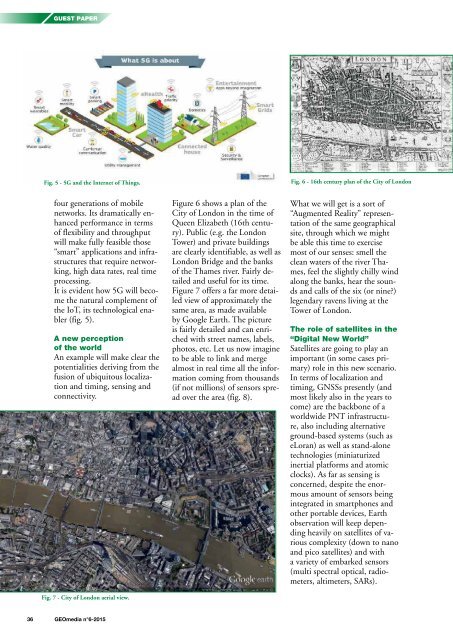Create successful ePaper yourself
Turn your PDF publications into a flip-book with our unique Google optimized e-Paper software.
GUEST PAPER<br />
Fig. 5 - 5G and the Internet of Things.<br />
Fig. 6 - 16th century plan of the City of London<br />
four generations of mobile<br />
networks. Its dramatically enhanced<br />
performance in terms<br />
of flexibility and throughput<br />
will make fully feasible those<br />
“smart” applications and infrastructures<br />
that require networking,<br />
high data rates, real time<br />
processing.<br />
It is evident how 5G will become<br />
the natural complement of<br />
the IoT, its technological enabler<br />
(fig. 5).<br />
A new perception<br />
of the world<br />
An example will make clear the<br />
potentialities deriving from the<br />
fusion of ubiquitous localization<br />
and timing, sensing and<br />
connectivity.<br />
Fig. 7 - City of London aerial view.<br />
Figure 6 shows a plan of the<br />
City of London in the time of<br />
Queen Elizabeth (16th century).<br />
Public (e.g. the London<br />
Tower) and private buildings<br />
are clearly identifiable, as well as<br />
London Bridge and the banks<br />
of the Thames river. Fairly detailed<br />
and useful for its time.<br />
Figure 7 offers a far more detailed<br />
view of approximately the<br />
same area, as made available<br />
by Google Earth. The picture<br />
is fairly detailed and can enriched<br />
with street names, labels,<br />
photos, etc. Let us now imagine<br />
to be able to link and merge<br />
almost in real time all the information<br />
coming from thousands<br />
(if not millions) of sensors spread<br />
over the area (fig. 8).<br />
What we will get is a sort of<br />
“Augmented Reality” representation<br />
of the same geographical<br />
site, through which we might<br />
be able this time to exercise<br />
most of our senses: smell the<br />
clean waters of the river Thames,<br />
feel the slightly chilly wind<br />
along the banks, hear the sounds<br />
and calls of the six (or nine?)<br />
legendary ravens living at the<br />
Tower of London.<br />
The role of satellites in the<br />
“Digital New World”<br />
Satellites are going to play an<br />
important (in some cases primary)<br />
role in this new scenario.<br />
In terms of localization and<br />
timing, GNSSs presently (and<br />
most likely also in the years to<br />
come) are the backbone of a<br />
worldwide PNT infrastructure,<br />
also including alternative<br />
ground-based systems (such as<br />
eLoran) as well as stand-alone<br />
technologies (miniaturized<br />
inertial platforms and atomic<br />
clocks). As far as sensing is<br />
concerned, despite the enormous<br />
amount of sensors being<br />
integrated in smartphones and<br />
other portable devices, Earth<br />
observation will keep depending<br />
heavily on satellites of various<br />
complexity (down to nano<br />
and pico satellites) and with<br />
a variety of embarked sensors<br />
(multi spectral optical, radiometers,<br />
altimeters, SARs).<br />
36 <strong>GEOmedia</strong> n°6-2015


















